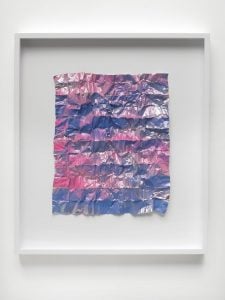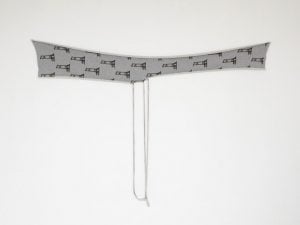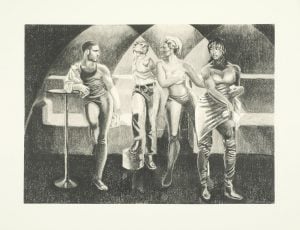Rana Begum - No. 889 Folded Grid - 2019
 Rana Begum has created a series of 20 unique works made from spray-painted aluminium foil to accompany the exhibition Is This Tomorrow?, 14 February – 12 May 2019. The series relates to her exhibited work with Marina Tabassum Architects, Phoenix Will Rise, 2019, of the same medium. The edition forms part of Begum's ongoing exploration into the process of making using various materials such as foil, paper and jesmonite.
Rana Begum has created a series of 20 unique works made from spray-painted aluminium foil to accompany the exhibition Is This Tomorrow?, 14 February – 12 May 2019. The series relates to her exhibited work with Marina Tabassum Architects, Phoenix Will Rise, 2019, of the same medium. The edition forms part of Begum's ongoing exploration into the process of making using various materials such as foil, paper and jesmonite.
In this series Begum moves away from a symmetrical grid by introducing a more organic geometry. Begum retains traces of the grid, achieved by hand-folding, but also incorporates a disruptive element by unfolding and scrunching the paper; an element of chance exists within the work.
For Begum, the work is influenced by both the urban environment and faceted landscapes. The array of reflective effects created when the surface is sprayed evokes a landscape that seems other worldly.
Medium: Spray paint on aluminium foil in artist's frame.
Size: 41.2 x 36.2 cm (framed).
Series of 20 each unique
Signed and numbered
Price: £ 1,700 (WG-Members: £ 1,530)
Simon Fujiwara - Jersey Sweat Relax-Revolution Scarf with Shred Detail - 2019
 Fujiwara takes the symbolism of the guillotine and applies it to his Whitechapel edition, a scarf made from cotton jersey. Invented in the French Revolution, the guillotine replaced earlier execution methods. Previously peasants and commoners sentenced to death were hung and the nobility decapitated by a sword yielding executioner. Partly in response to the high number of executions taking place and also to a new democratic ideology, the nation needed an efficient single form of execution “for everybody”.
Fujiwara takes the symbolism of the guillotine and applies it to his Whitechapel edition, a scarf made from cotton jersey. Invented in the French Revolution, the guillotine replaced earlier execution methods. Previously peasants and commoners sentenced to death were hung and the nobility decapitated by a sword yielding executioner. Partly in response to the high number of executions taking place and also to a new democratic ideology, the nation needed an efficient single form of execution “for everybody”.
The guillotine symbol has been monogrammed, turning it into a repeating motif, hinting at the way aesthetics today, through fashion and through hyper capitalism and mass media, have disrupted the value of historic symbols, or indeed any symbols as marketable commodities. The guillotine - a machine that once signaled terror- is now a “cute” motif. The fabric on which the motif is printed, a grey sweatshirt jersey was commonly associated with lower classes as a ‘lazy’ or ‘low’ material. Since the ‘athleisure’ and fitness ‘revolution’ as well as the breakdown of aesthetics in relation to wealth, the material is worn across the board by all classes and wealth brackets. The two symbols of democracy, a world ‘for all’ are brought together, for Fujiwara, a positive thing.
Fujiwara intends for the work to be either hung on a wall or worn. The shredded detail can be seen as homage to the guillotines original function, but also as a way for the wearer to adapt the scarf to their individual style.
Medium: Cotton with digital print.
Size: 30 x 155 cm.
Edition of 50
Accompanied by signed and numbered certificate.
Price: £ 150 (WG-Members: £ 135)
Hannah Quinlan and Rosie Hastings - Lonely City - 2019
 Hannah Quinlan and Rosie Hastings have produced Lonely City, 2019, a photopolymer etching in an edition of 30, especially for Whitechapel Gallery to accompany the exhibition Queer Spaces: London, 1980's - Today, 2 April – 25 August 2019.
Hannah Quinlan and Rosie Hastings have produced Lonely City, 2019, a photopolymer etching in an edition of 30, especially for Whitechapel Gallery to accompany the exhibition Queer Spaces: London, 1980's - Today, 2 April – 25 August 2019.
The photopolymer etching translates the softness of colour pastel, the medium in which the original drawing was created. Quinlan and Hastings choose to work in pastel as it feels to them like a looser and less uptight way of working, lending itself to the nightclub setting of the work.
The scene in Lonely City portrays a small and easily forgotten conflict on the dance floor between a sneering gay man and a group of friends. Inspired by the work of Denzil Forrester whose colourful club scenes from the 1980's are haunted by the presence of the police and potential violence. To Quinlan and Hastings, it is important to convey the energy of the dancefloor as being so powerful that the clubbers’ lust for life cannot be broken.
Drawing allows Quinlan and Hastings to probe, analyse and re-present the dynamics of the gay clubbing scene in an imaginary realm. Their drawings reveal worlds full of dreamlike uncertainty, populated by heroic characters on the cusp of love or violence. “It felt like we were digging into the collective queer unconscious, and reveling in the joys and anxieties that define everyday queer life.”
Medium: Photopolymer etching.
Size: 37.5 x 48.9 cm.
Edition of 30
Signed and numbered
Price: £ 150 (WG-Members: £ 135)
These limited edition works are available at Whitechapel Gallery







